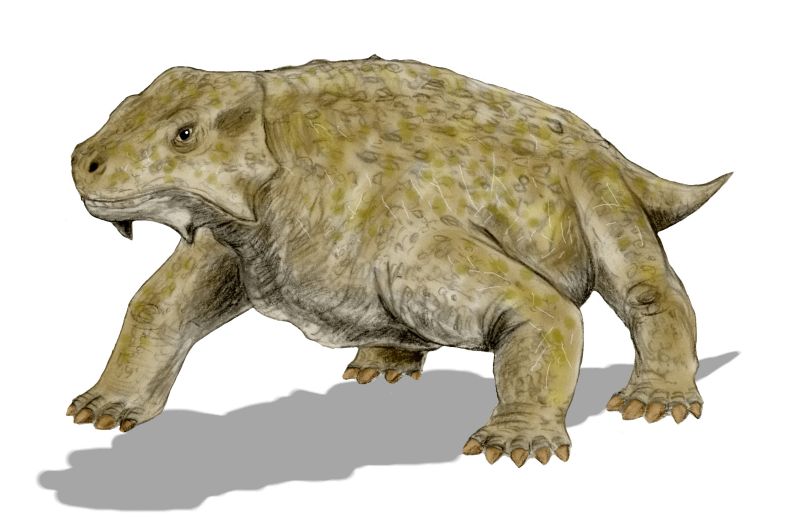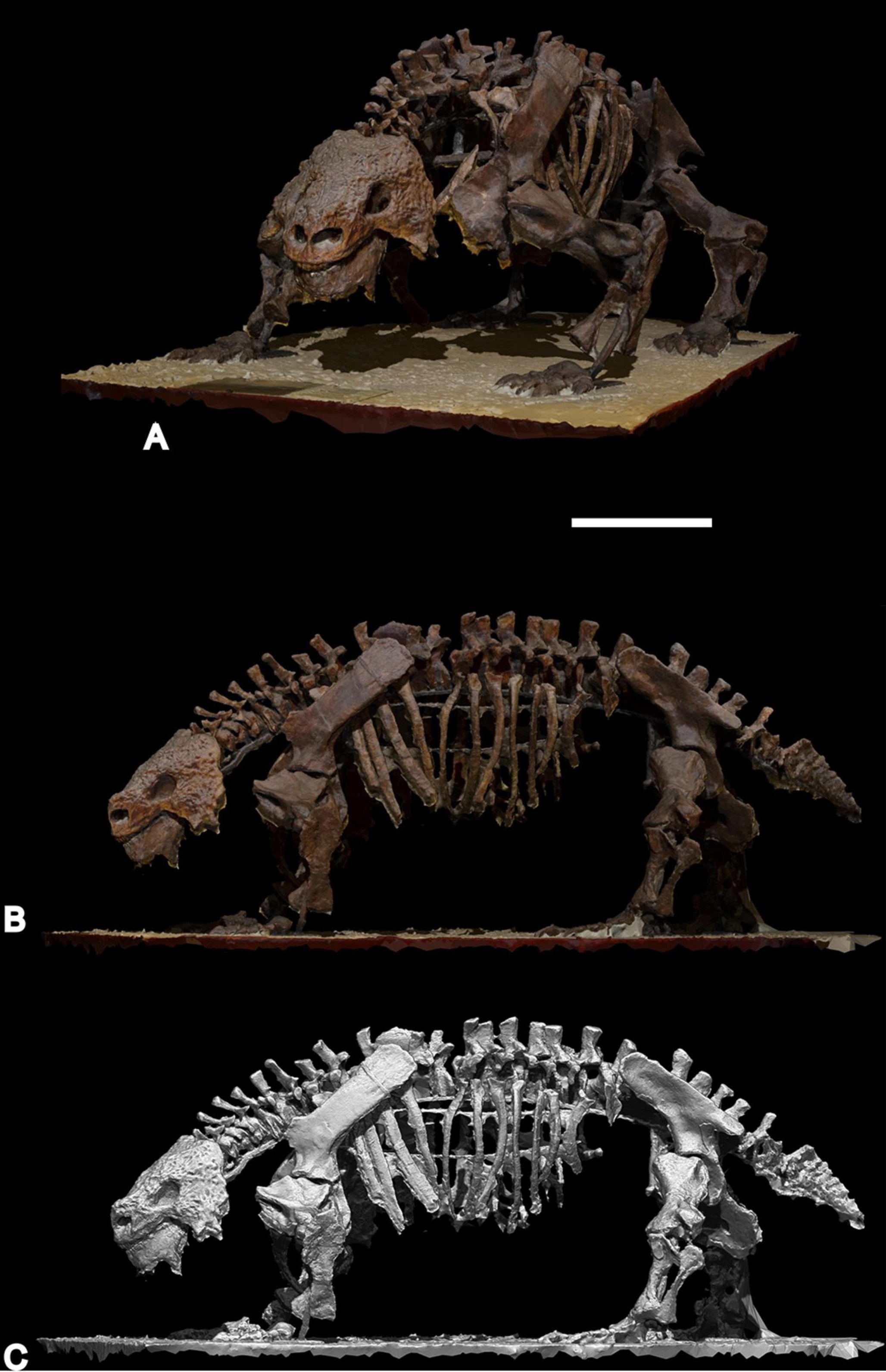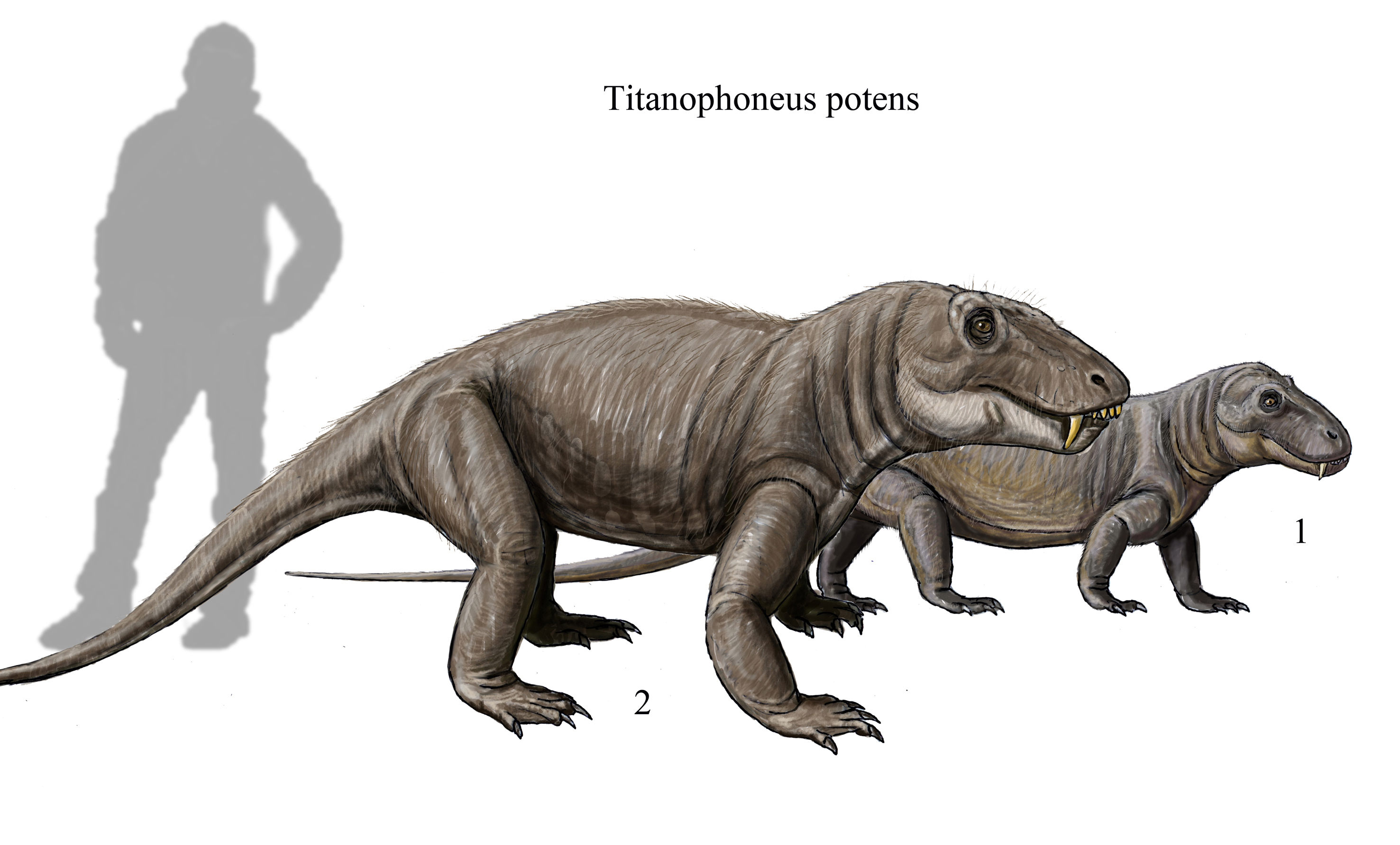|
Pareiasaurs
Pareiasaurs (meaning "cheek lizards") are an extinct clade of large, herbivorous parareptiles. Members of the group were armoured with osteoderms which covered large areas of the body. They first appeared in southern Pangea during the Middle Permian, before becoming globally distributed during the Late Permian. Pareiasaurs were the largest reptiles of the Permian, some reaching sizes over , equivalent to the largest contemporary therapsids. Pareiasaurs became extinct in the end-Permian mass extinction event. Description Pareiasaurs ranged in size from long, with some species estimated to exceed in body mass. The limbs of many parieasaurs were extremely robust, likely to account for the increased stress on their limbs caused by their typically sprawling posture. The cow-sized ''Bunostegos'' differed from other pareiasaurs by having a more upright limb posture, being amongst the first amniotes to develop this trait. Pareiasaurs were protected by bony scutes called osteoderms th ... [...More Info...] [...Related Items...] OR: [Wikipedia] [Google] [Baidu] |
Scutosaurus
''Scutosaurus'' ("shield lizard") is an extinct genus of pareiasaur parareptiles. Its genus name refers to large plates of armor scattered across its body. It was a large anapsid reptile that, unlike most reptiles, held its legs underneath its body to support its great weight. Fossils have been found in the Sokolki Assemblage Zone of the Malokinelskaya Formation in European Russia, close to the Ural Mountains, dating to the late Permian (Lopingian) between 264 and 252 million years ago. Research history The first fossils were uncovered by Russian paleontologist Vladimir Prokhorovich Amalitskii while documenting plant and animal species in the Upper Permian sediments in the Northern Dvina River, Arkhangelsk Oblast, Arkhangelsk District, Northern European Russia. Amalitskii had discovered the site in 1899, and he and his wife Anne Amalitskii continued to oversee excavation until 1914, recovering numerous nearly complete and articulated (in their natural position) skeletons belon ... [...More Info...] [...Related Items...] OR: [Wikipedia] [Google] [Baidu] |
Obirkovia
''Obirkovia'' is an extinct genus of pareiasaur from the late Permian Salarevo Formation of Russia. The genus contains a single species, ''O. gladiator'', known from a left quadratojugal. Discovery and naming The ''Obirkovia'' holotype specimen, PIN, no. 4546/18, was discovered in sediments of the Salarevo Formation (Vyatka Horizon) at the Obirkovo locality in Babushkinskii District of Vologda Oblast, Russia. The specimen consists of a single left quadratojugal. In 2005, Bulanov & Yashina described ''Obirkovia gladiator'' as a new genus and species of elginiid pareiasaur based on these fossil remains. The generic name, "'Obirkovia''", references the locality where the holotype was discovered. The specific name, "''gladiator''", references the armed combatants of Ancient Rome. Classification Cisneros, Dentzien-Dias & Francischini (2021) recovered ''Obirkovia'' as an elginiid member of the Pareiasauria, in a clade that also contains ''Elginia'' spp. and ''Arganaceras ... [...More Info...] [...Related Items...] OR: [Wikipedia] [Google] [Baidu] |
Sanchuansaurus
''Sanchuansaurus'' is an extinct genus of pareiasaur from the late Permian Sunjiagou Formation of China. The genus contains a single species, ''S. pygmaeus'', known from a partial maxilla and left leg bones. A 2013 study suggested that both ''Sanchuansaurus'' and another Chinese pareiasaur, ''Huanghesaurus'', were synonymous with ''Shansisaurus''. However, this has not been followed in future research, with later papers considering ''Sanchuansaurus'' to be distinct, with ''Huanghesaurus'' and ''Shansisaurus'' possibly being synonymous with ''Shihtienfenia ''Shihtienfenia'' is an extinct genus of pareiasaurid parareptile from the Late Permian of China. Species Lee (1997) refers to ''S. xuecunensis'' as a metaspecies lacking the autapomorphies of ''Shihtienfenia''. Tsuji & Müller (2009) seem to ...'', another Chinese pareiasaur. References {{Taxonbar, from=Q124059882 Pareiasauria Permian China Prehistoric animals of China Permian reptiles of Asia Prehistoric re ... [...More Info...] [...Related Items...] OR: [Wikipedia] [Google] [Baidu] |
Middle Permian
The Guadalupian is the second and middle series/epoch of the Permian. The Guadalupian was preceded by the Cisuralian and followed by the Lopingian. It is named after the Guadalupe Mountains of New Mexico and Texas, and dates between 272.95 ± 0.5 – 259.1 ± 0.4 Mya. The series saw the rise of the therapsids, a minor extinction event called Olson's Extinction and a significant mass extinction called the end-Capitanian extinction event. The Guadalupian is also known as the Middle Permian. Name and background The Guadalupian is the second and middle series or epoch of the Permian. Previously called Middle Permian, the name of this epoch is part of a revision of Permian stratigraphy for standard global correlation. The name "Guadalupian" was first proposed in the early 1900s, and approved by the International Subcommission on Permian Stratigraphy in 1996. References to the Middle Permian still exist. The Guadalupian was preceded by the Cisuralian and followed by the Lopingian. ... [...More Info...] [...Related Items...] OR: [Wikipedia] [Google] [Baidu] |
Pumiliopareia
''Pumiliopareia'' is an extinct genus of pareiasaurid parareptile from the Permian period of South Africa. It is known from a complete skeleton with osteoderms. Description ''Pumiliopareia'' was about 50 cm (19.6 in) in length with a 12 cm (4.7 in) skull. It is the smallest known member of the pareiasaurs, measuring only a fifth as long as some of its larger relatives. Like '' Anthodon'', its body was entirely covered with osteoderms. In analyses that support a pareiasaur origin of turtles, the sister taxon of the testudines. However it specifically shares with turtles a single trait only: Ribs greatly expanded anteroposteriorly (i.e. wide). Classification Originally included under the genus '' Nanoparia'', it was given its own name by Lee 1997 who found it did not form a clade with ''Nanoparia luckhoffi'', the type species of that genus, and preferred to have monophyletic genera. ''Nanoparia'' may still be a paraphyletic Paraphyly is a taxonomic term describing ... [...More Info...] [...Related Items...] OR: [Wikipedia] [Google] [Baidu] |
Pangaea
Pangaea or Pangea ( ) was a supercontinent that existed during the late Paleozoic and early Mesozoic eras. It assembled from the earlier continental units of Gondwana, Euramerica and Siberia during the Carboniferous period approximately 335 million years ago, and began to break apart about 200 million years ago, at the end of the Triassic and beginning of the Jurassic. Pangaea was C-shaped, with the bulk of its mass stretching between Earth's northern and southern polar regions and surrounded by the superocean Panthalassa and the Paleo-Tethys and subsequent Tethys Oceans. Pangaea is the most recent supercontinent to have existed and was the first to be reconstructed by geologists. Origin of the concept The name "Pangaea" is derived from Ancient Greek ''pan'' (, "all, entire, whole") and '' Gaia'' or Gaea (, " Mother Earth, land"). The first to suggest that the continents were once joined and later separated may have been Abraham Ortelius in 1596. The concept that the c ... [...More Info...] [...Related Items...] OR: [Wikipedia] [Google] [Baidu] |
Osteoderms
Osteoderms are bony deposits forming scales, plates, or other structures based in the dermis. Osteoderms are found in many groups of Extant taxon, extant and extinct reptiles and amphibians, including lizards, crocodilians, frogs, Temnospondyli, temnospondyls (extinct amphibians), various groups of dinosaurs (most notably ankylosaurs and stegosaurians), phytosaurs, aetosaurs, placodonts, and hupehsuchians (marine reptiles with possible ichthyosaur affinities). Osteoderms are uncommon in mammals, although they have occurred in many xenarthrans (armadillos and the extinct glyptodonts and Mylodontidae, mylodontid ground sloths). The heavy, bony osteoderms have evolved independently in many different lineages. The armadillo osteoderm is believed to develop in subcutaneous dermal tissues. These varied structures should be thought of as anatomical analogues, not homology (biology), homologues, and do not necessarily indicate monophyly. The structures are however derived from scute, sc ... [...More Info...] [...Related Items...] OR: [Wikipedia] [Google] [Baidu] |
Parareptilia
Parareptilia ("near-reptiles") is an extinct group of basal sauropsids (" reptiles"), traditionally considered the sister taxon to Eureptilia (the group that likely contains all living reptiles and birds). Parareptiles first arose near the end of the Carboniferous period and achieved their highest diversity during the Permian period. Several ecological innovations were first accomplished by parareptiles among reptiles. These include the first reptiles to return to marine ecosystems (mesosaurs), the first bipedal reptiles ( bolosaurids such as '' Eudibamus''), the first reptiles with advanced hearing systems ( nycteroleterids and others), and the first large herbivorous reptiles (the pareiasaurs). The only parareptiles to survive into the Triassic period were the procolophonoids, a group of small generalists, omnivores, and herbivores. The largest family of procolophonoids, the procolophonids, rediversified in the Triassic, but subsequently declined and became extinct by t ... [...More Info...] [...Related Items...] OR: [Wikipedia] [Google] [Baidu] |
Elginia
''Elginia'' is an extinct genus of pareiasaurid known from the Late Permian of Scotland and China. It was named for the area around Elgin, Moray, Elgin in Scotland, which has yielded many fossils referred to as the Elgin Reptiles. Discovery The type species of ''Elginia, Elginia mirabilis,'' was first described in 1893 by Edwin Tulley Newton, E.T. Newton, after fellow geologists John Horne and Archibald Geikie informed him of several unusual specimens stored at the Elgin Museum (Moray), Elgin Museum in Scotland. The specimens were collected several years earlier from the coarse sandstones of the nearby Cutties Hillock Quarry. The quarry’s sandstone, the Cutties Hillock Sandstone Formation, is often (but not always) considered equivalent to the otherwise fossil-poor Hopeman Sandstone Formation of broader Scottish geology. Tetrapod remains occupy a narrow section of the sandstone, lying above a pebbly layer. The sandstones of Cutties Hillock were deposited at the very end of ... [...More Info...] [...Related Items...] OR: [Wikipedia] [Google] [Baidu] |
Arganaceras
''Arganaceras'' ("Argana horn") is a medium-sized pareiasaur Pareiasaurs (meaning "cheek lizards") are an extinct clade of large, herbivorous parareptiles. Members of the group were armoured with osteoderms which covered large areas of the body. They first appeared in southern Pangea during the Middle Per ... from the Late Permian Ikakern Formation of Morocco. It was about in length and had a horn-like structure on its snout. References Pareiasauria Lopingian reptiles of Africa Lopingian life Wuchiapingian life Fossils of Morocco Fossil taxa described in 2005 Prehistoric reptile genera {{permian-reptile-stub ... [...More Info...] [...Related Items...] OR: [Wikipedia] [Google] [Baidu] |
Shihtienfenia
''Shihtienfenia'' is an extinct genus of pareiasaurid parareptile from the Late Permian of China. Species Lee (1997) refers to ''S. xuecunensis'' as a metaspecies lacking the autapomorphies of ''Shihtienfenia''. Tsuji & Müller (2009) seem to consider it a valid taxon for cladistic analysis, and like Lee 1997 place the two Chinese species close to '' Pareiasuchus''. ''S. permica'' (Young and Yeh, 1963); The skull of this pareiasaur is unknown. It is known originally from a number of isolated vertebrae, jaws, and limb-bones and an incomplete skeleton, all from the Shiqianfeng locality near Baode, Shanxi Shanxi; Chinese postal romanization, formerly romanised as Shansi is a Provinces of China, province in North China. Its capital and largest city of the province is Taiyuan, while its next most populated prefecture-level cities are Changzhi a ..., part of the Sunjiagou Formation. ''Shanshisaurus xuecunensis'' Cheng, 1980 and ''Huanghesaurus liuliensis'' Gao, 1983 are syn ... [...More Info...] [...Related Items...] OR: [Wikipedia] [Google] [Baidu] |







